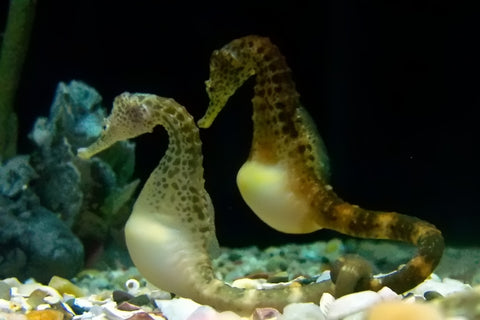The syngnathids (a name which comes from the Greek for “fused jaws”) are a unique looking family of fish encompassing the well known, charismatic seahorses, as well as the pipefishes, pipehorses and seadragons. These fish are found in warm seas worldwide, usually in coastal waters. Characteristic of the syngnathidae are jaws fused into an elongated, pipe-like snout, lack of pelvic fins, a coat of bony armour, and perhaps most fascinating, the male’s role in the care of eggs.

The way syngnathids breed and care for their eggs is unique; the females lay their eggs on the tail or abdomen of the male, often in specialized pouches, making it a form of male pregnancy. The seahorses have the most specialized form of this type of reproduction, having a fully enclosed pouch on their abdomen for the development of eggs. Similar to the mammalian uterus, the pouch of the male seahorse provides a homeostatic environment for the development of eggs, it even provides some nutrients and has antibacterial properties. By keeping their eggs safe in a pouch, male syngnathids are able to ensure that more of them survive. Because it’s the male that provides care for the eggs, many syngnathid species exhibit reverse sexual selection; it’s the females that compete with each other for access to males.
Seahorses are some of the slowest moving fish in the ocean, yet they are one of the most successful copepod hunters. The dwarf seahorse, Hippocampus zosterae, is able to position itself within 1mm, striking distance, without eliciting an escape response from copepods 84% of the time; once H.zosterae is in the strike zone its capture success is 94%! This tiny seahorse owes its hunting success to its slow movement and equine shaped head which both help to minimize hydrodynamic disturbance, and a unique strike technique known as ‘pivot feeding’. By storing and releasing elastic energy in its muscles and tendons, the seahorse is able to rapidly accelerate its head and cover the distance to its copepod prey in less than 1 millisecond, faster than the copepod’s escape response time of 2-4 milliseconds.
Example of Pivot feeding:
Harpacticoid copepods are abundant in the seagrass environments of many seahorses and pipefish and studies have shown that they compromise the largest part of their natural diets. So why shouldn’t captive pipefish and seahorses eat what their wild counterparts eat in the wild? Offering live food to captive syngnathids is a great way to get finicky eaters to feed, see more natural behaviour and provide a better nutritional profile.
References
Gemmell, B.J., Sheng, J., Buskey, E.J., 2013. Morphology of seahorse head hydrodynamically aids in capture of evasive prey. Nature Communications. 4:2840
Stölting, K.N., Wilson, A.B., 2007. Male pregnancy in seahorses and pipefish: beyond the mammalian model. BioEssays. 29:884-896
Tipton, K., Bell, S.S., 1988. Foraging patterns of two syngnathid fishes: importance of harpacticoid copepods. Marine Ecology. 47:31-43
Joanne Merriam, PotbellySeahorse TNAquarium, CC BY-SA 3.0
